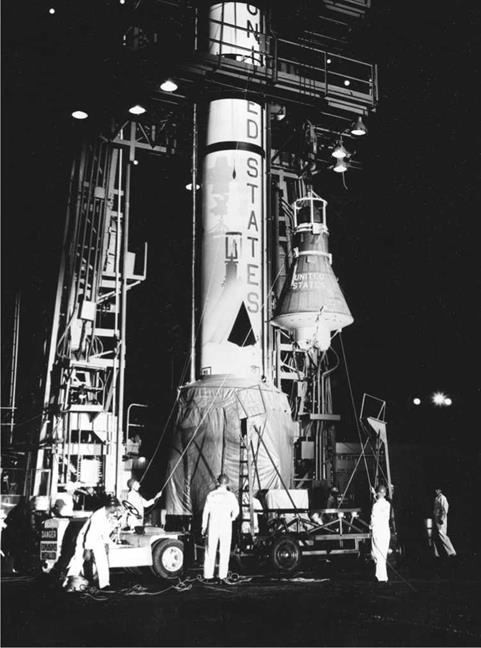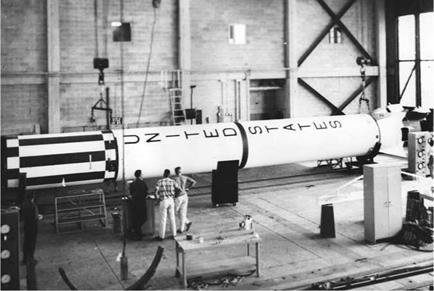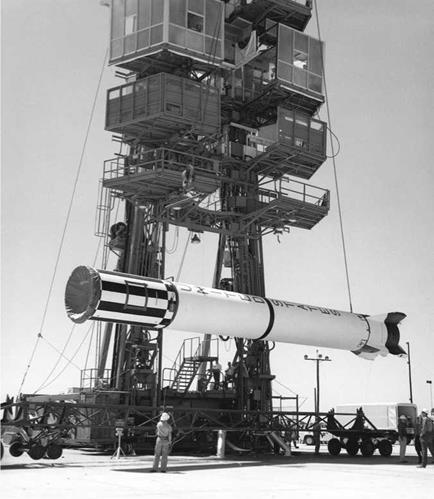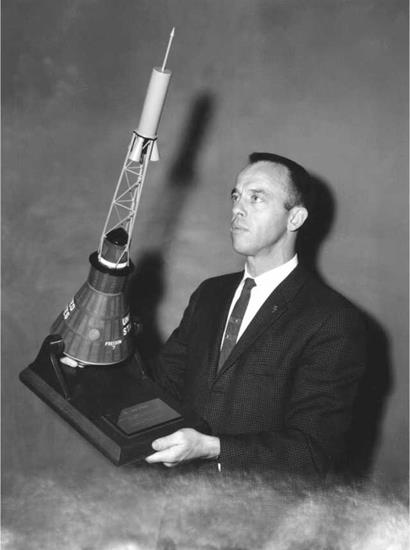CAUTION WINS, AMERICA LOSES
At 11:55 on the morning of 31 January 1961, chimpanzee Ham was launched on the suborbital MR-2 flight. The Redstone climbed steeply and then headed downrange over the Atlantic Missile Range to where a fleet of Navy vessels was stationed in the target zone some 290 miles from the Cape. Due to the spacecraft overshooting its intended splashdown area and Ham experiencing a rough reentry that exposed him to a hefty load of 18 g’s, there were fears that the chimpanzee might not have survived. However, after the capsule was recovered, the attending veterinarian, Maj. Richard Benson, pronounced Ham to be “healthy and happy.”
While there was relief that Ham’s flight had ended well, Shepard was unshakable in his belief that a human astronaut should have occupied that capsule.
“I reviewed the telemetry tapes and records of the Great Chimp Adventure. I knew I could’ve survived that trip, but I also knew immediately that my own planned flight was in deep trouble. If only the damn chimp’s ride had been on the mark, I’d have launched in March.
“But Ham’s flight had not been on the mark, and in Huntsville, Alabama, Dr. Wernher von Braun, developer of the Redstone and director of the Marshall Space Flight Center, was showing signs of a new conservatism as responsibility for men’s lives was factored into his decisions. ‘We require another unmanned Mercury-Redstone flight,’ he said. Working with the engineers, I confirmed that the problem with Ham’s Redstone had been nothing more than a minor electrical relay. The fix was quick and easy, and the Redstone was back in perfect shape. ‘For God’s sake, let’s fly. Now!’ I begged NASA officials, but Dr. von Braun stood fast: ‘Another test flight.’ I stalked off
|
Redstone rocket No. MR7 that was to boost Freedom 7 into space is prepared for transportation to Cape Canaveral. (Photo: NASA) |
|
The MR-3 Redstone booster being raised onto the launch pedestal. (Photo: NASA) |
steaming to the office of Flight Director Chris Kraft. ‘Look, Chris, we’re pilots,’ I said. ‘When there’s a failure, dammit, we fix it.’
“‘I know, Alan,’ he said.
“‘Well, what about it? It’s an established fact that the relay was the problem, and it’s fixed.’
“‘Right.’
“‘So why don’t we go ahead? Why don’t we man the next one?’
“‘Why waste time, right?’ Kraft smiled.
“‘Right.’
‘“Because when it comes to rockets’ – the flight director shook his head – ‘Wernher is king.’
“‘King?’

|
“‘King.’
“‘Forget it, right?’
“‘Right.’
“So I walked away, brooding. The March 24 Redstone flight was an absolute beauty. I could’ve killed. I should’ve been on that flight. I could’ve led the world into space. I should’ve been floating up there, while the Russians were still wrestling with a balky rocket booster.”
By the time Shepard’s flight was ready to go, Yuri Gagarin had already been there and back.
|
A publicity photo of Alan Shepard holding a model of a Mercury spacecraft and its escape tower. (Photo: NASA) |
“So that was that,” Shepard pointed out ruefully. “Nearly four years after Sputnik started the Space Race and two years after I and my six colleagues – Scott Carpenter, Gordon Cooper, John Glenn, Virgil (‘Gus’) Grissom, Wally Schirra, and Deke Slayton – were presented in a Washington, D. C., ceremony as the Mercury Project team that would represent America in space, we’d been beaten to the punch. We had them by the short hairs, and we gave it away.” [34]
As Guenter Wendt reflected, “As we busied ourselves incorporating the latest changes into the spacecraft, Glenn, Grissom and Shepard stayed busy in the simulator in Hangar S. The three prime candidates for the first Mercury flight spent 50 to 60 hours a week working on procedures in the simulator. During that period, Shepard made about 120 simulated flights, some in the sim[ulator] and some in the altitude chamber. In spite of the fact that Gagarin had orbited the Earth, and our first flight would only be suborbital, our Mercury was much more sophisticated than their Vostok. Of course we didn’t know it at the time, but the lead we had in spacecraft systems was one that we would never relinquish.” [35]













